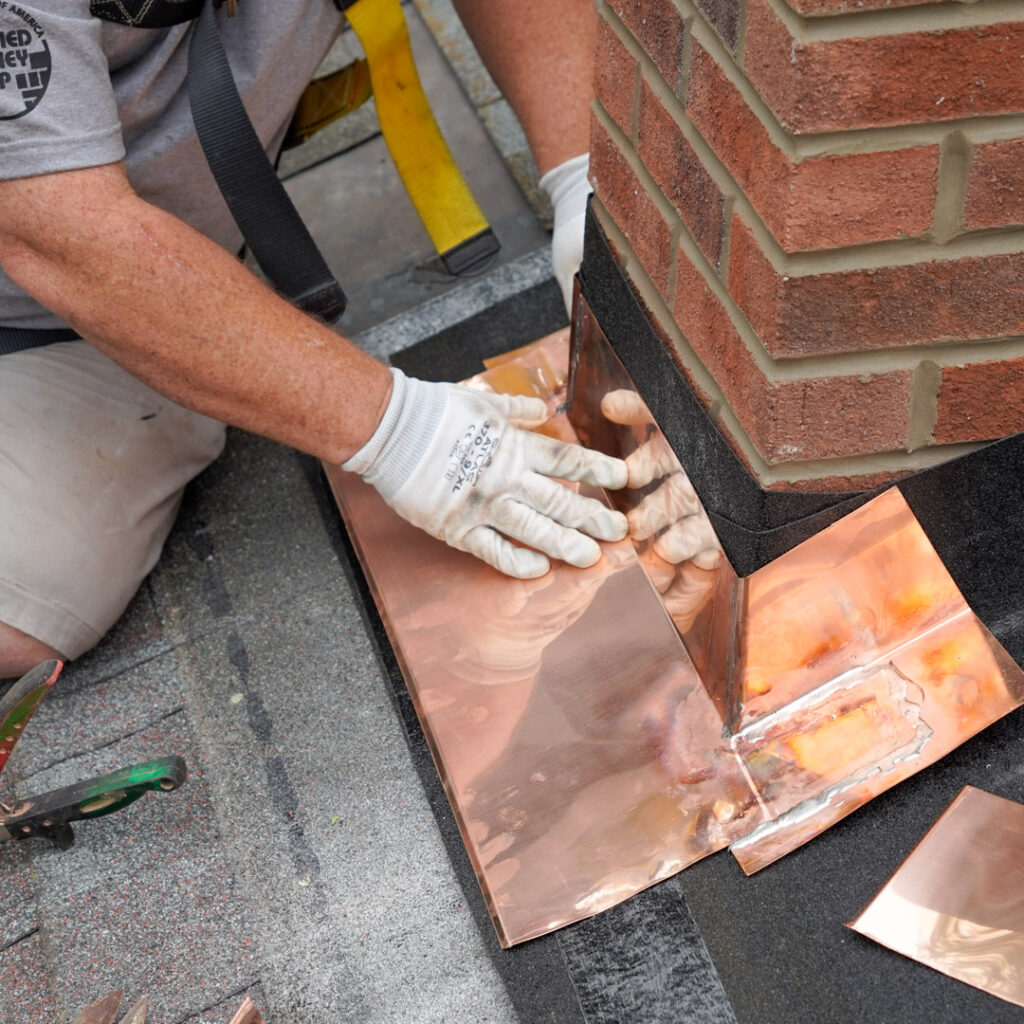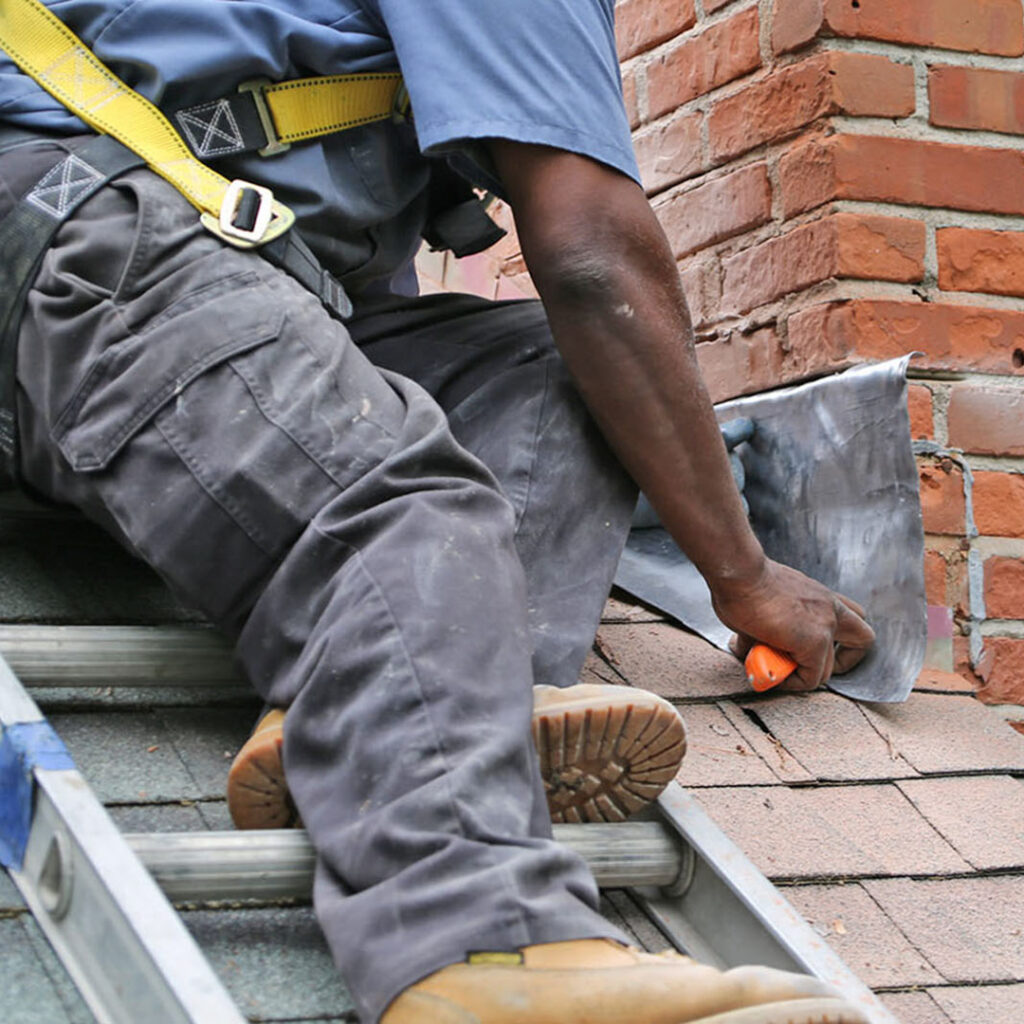Chimney flashing is one of those critical components of your home that often goes unnoticed until there’s an issue. It’s a small but mighty element that protects your roof and interior from costly water damage. Here’s how flashing gets damaged and how we can fix it.
 What is Chimney Flashing?
What is Chimney Flashing?
Chimney flashing is a thin layer of metal—usually aluminum, galvanized steel, or copper—that’s installed at the point where the chimney meets the roof. Its primary job is to create a waterproof seal and direct water away from the vulnerable seam between the chimney and roofing materials.
Most chimney flashing systems consist of two main parts:
Step flashing
This is installed in layers with the shingles, going up the side of the chimney.
Counter flashing
This is embedded into the chimney mortar and overlaps the step flashing to seal everything in.
When properly installed, flashing acts like a fortress against rain, snow, and melting ice, keeping moisture out of the attic and preventing interior ceiling and wall stains, mold growth, and structural rot.
How Flashing Gets Damaged
Weather Damage
Flashing is constantly exposed to the elements. Heavy rains, strong winds, snow, and temperature swings can loosen or warp the metal, especially if the flashing wasn’t installed or sealed properly.
Corrosion and Rust
Depending on the material, flashing can rust or corrode over time. Galvanized steel, for instance, will eventually rust if the protective coating wears off. Once rust sets in, the metal becomes brittle and prone to breaking.
Poor Installation
Unfortunately, not all contractors do the best job. Improperly installed flashing—flashing that wasn’t embedded into the chimney mortar or wasn’t layered correctly with the shingles—can allow water to easily get in.
Settling or Shifting
As homes settle, roofing materials and chimneys can shift slightly. Even small movements can pull flashing loose or create gaps where water can seep through.
Deteriorating Mortar
Even if the flashing is intact, if the mortar joints around the chimney are crumbling, the counter flashing may become loose and ineffective.
Our Flashing Repair Methods
If you suspect your chimney flashing is damaged, it’s crucial to call us for repairs and an inspection. Water intrusion can cause extensive damage before it’s visible inside the home. Here’s how we can fix your flashing.
Inspection
As mentioned, the first thing we’ll do is conduct a thorough inspection of the flashing and surrounding materials for signs of rust, gaps, loose flashing, and deteriorated caulk and mortar. We’ll also check the interior attic for signs of leaks and moisture.
Re-Sealing
If the flashing is still in decent shape but has small gaps or deteriorating caulking, we can seal it with a high-quality roofing sealant or cement. This is often a short-term solution, but it can buy time before a full replacement is necessary.
Partial Flashing Replacement
If only a section of the flashing is damaged, such as a rusty corner or loose piece, we might remove just the affected area and install new flashing without tearing apart the entire chimney system.
 Full Flashing Replacement
Full Flashing Replacement
If the flashing is extensively corroded or improperly installed, a full replacement might be the best option. We can remove the old flashing and replace it to ensure everything is properly sealed.
Mortar Repair
If deteriorating mortar is the problem, we can perform tuckpointing to remove the old mortar and replace it with fresh mortar. This ensures the counter flashing has a solid, secure hold.
Don’t Ignore Flashing Problems
Chimney flashing might not be at the top of your “things to check” list, but it’s a necessary protector against water damage. If you see signs of leaks around the chimney, water stains in the attic, or bits of rusted metal near your gutters, it might be time to call the professionals at Motown Fire.
We’re the most trusted fireplace and chimney company in the Detroit metro area, proudly serving Chesterfield, MI, Grosse Pointe, Park, MI, Grosse Pointe Shores, MI, Grosse Pointe Woods, MI, St. Clair Shores, MI, Auburn Hills, and the surrounding neighborhoods.



